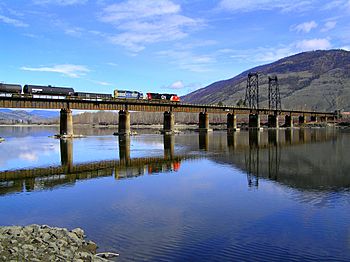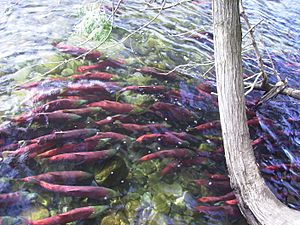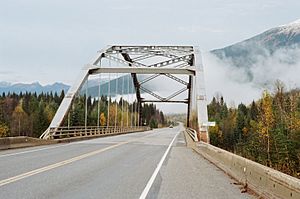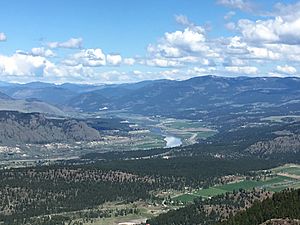Thompson River facts for kids
Quick facts for kids Thompson River |
|
|---|---|

|
|

A map of the Thompson River's watershed
|
|
| Country | Canada |
| Province | British Columbia |
| Physical characteristics | |
| Main source | Confluence of the North & South Thompson Rivers Kamloops 345 m (1,132 ft) 50°40′49″N 120°20′36″W / 50.68028°N 120.34333°W |
| River mouth | Fraser River Lytton 195 m (640 ft) 50°14′07″N 121°35′00″W / 50.23528°N 121.58333°W |
| Length | 489 km (304 mi) |
| Basin features | |
| Basin size | 56,000 km2 (22,000 sq mi) |
The Thompson River is a big river in British Columbia, Canada. It's the largest river that flows into the Fraser River. The Thompson River has two main parts: the South Thompson River and the North Thompson River. Many types of Pacific salmon and trout live here.
The land around the river was shaped by glaciers long ago. Large lakes filled the valley over the last 12,000 years. People have lived in this area for at least 8,300 years. The river was named by explorer Simon Fraser. He named it after his friend, David Thompson, who explored the Columbia Basin. Today, people enjoy whitewater rafting and fishing on the river.
Contents
Exploring the Thompson River's Geography
The Thompson River system is made up of two main branches. These are the South Thompson River and the North Thompson River. They meet to form the main Thompson River.
Journey of the South Thompson River
The South Thompson River starts at Little Shuswap Lake near the town of Chase. It flows about 55 kilometres (34 mi) southwest to Kamloops. Here, it joins the North Thompson. Highway 1, the Trans-Canada Highway, and the Canadian Pacific Railway run alongside this part of the river. Little Shuswap Lake gets its water from the Little River. The Little River drains Shuswap Lake, which is fed by many other rivers and creeks.
Journey of the North Thompson River
The North Thompson River begins at the Thompson Glacier in the Cariboo Mountains. This is west of Valemount. It flows south towards Kamloops, where it meets the South Thompson. Highway 5 and the Canadian National Railway follow the river for most of its length. They cross the river a few times.
The North Thompson passes through small towns like Blue River, Clearwater, and Barriere. The Clearwater River joins the North Thompson at the town of Clearwater. The Clearwater River is the North Thompson's biggest tributary. It drains a large part of Wells Gray Provincial Park.
A special spot on the North Thompson is Little Hells Gate. This is like a smaller version of the famous Hells Gate on the Fraser River. About 17.4 kilometres (10.8 mi) upstream from Avola, the river squeezes through a narrow gap. This gap is only about 30 feet (9.1 m) wide. It creates a fast-moving section of water.
The Main Thompson River Flow
In Kamloops, the North and South Thompson Rivers combine to form the main Thompson River. This combined river flows about 15 kilometres (9.3 mi) into Kamloops Lake. Kamloops Lake is about 30 kilometres (19 mi) long and ends at Savona. From Savona, the river winds west through a wide valley.
At Ashcroft, the Thompson Canyon begins. The river then turns southwest to meet the Fraser River. The Trans-Canada Highway and both the Canadian Pacific and Canadian National Railways run next to this part of the river.
The Thompson River flows through Thompson Canyon from Ashcroft to Lytton. This area has amazing scenery. The Thompson River finally joins the Fraser River in Lytton. There's a dark black cliffside called the Black Canyon just downstream from Ashcroft. Near Spences Bridge, there was a big train accident long ago. Other communities along this section include Bighorn, Shaw Springs, and Goldpan.
Understanding the Thompson River's Geology
The Thompson River valley has been around for at least 50 million years. However, it didn't always flow southwest to the Pacific Ocean like it does now. Scientists believe the river once flowed north through the Cariboo region. It then entered the Peace River basin and ended up in the Arctic Ocean. This changed about 2 million years ago when the Pleistocene ice age began.
How Glaciers Shaped the Lakes
During the ice age, huge glaciers filled the Thompson River valley. Water from the area likely flowed east into the Shuswap Lake area. This water then joined the Columbia River system. Large ice blocks in the Thompson valley created huge glacial lakes. Two big glacial lakes, Glacial Lake Thompson and Glacial Lake Deadman, covered much of the river's path from 13,000 BCE to 10,000 BCE.
These deep, narrow lakes held a lot of water. Glacial Lake Thompson held nearly 84 cubic kilometres (20 cu mi) of water at its highest point. It stretched from Spences Bridge in the west to the eastern parts of Shuswap Lake. It also went far up the North Thompson river valley. The last big glacial lake, Lake Deadman, emptied suddenly around 10,000 BCE. This happened when an ice dam broke, causing a huge flood called a jökulhlaup. This flood released about 20 cubic kilometres (4.8 cu mi) of water southwest into the Fraser River system. It might have carried dirt and rocks as far as the Salish Sea, over 250 kilometres (160 mi) away. After this, the Thompson River stopped flowing east into the Columbia River system. It became a tributary of the Fraser River.
Landslides in the Valley
The lower Thompson River valley has a lot of glacial silt, sand, and gravel. Because of this, large landslides are common. The area downstream from Ashcroft often has landslides. Eight major slides happened between 1880 and 1982. Some of these slides blocked the river, creating large, temporary lakes. An 1880 slide formed a lake over 14 kilometers long and 18 meters deep for a short time. These slides have caused a lot of damage to train tracks and farms in the valley. Heavy irrigation has been blamed for some of these events.
Thompson River History
First Peoples of the River
The interior of British Columbia was first settled after the big ice sheets of the last ice age melted. The ice left the Thompson River region around 11,000 BCE. The ancestors of the Nlaka'pamux and Secwepemc people likely moved in soon after. Some of the oldest places where people lived near the lower Thompson include the Drynoch Slide site, near Spences Bridge. Artifacts there are about 7350 BCE old. The Landels site, near Ashcroft, is even older, dating back more than 8000 BCE.
Archaeologists think early settlers lived in small groups. They started as nomadic hunters of animals like ungulates on the plateaus around the river. Later, they built more permanent homes along the river as they learned better fishing methods.
The South Thompson has the oldest proof of human life in the area. At the Gore site near Pritchard, human remains date to 8250 BCE. Bone analysis shows this person was a hunter who ate some salmon. Not much archaeological work has been done in the North Thompson. However, artifacts near Bridge Lake to the west are from 3000 BCE. Pieces found near the Clearwater River might be as old as 6000 to 7000 BCE.
European Exploration and Settlement
Simon Fraser, an explorer for the North West Company, named the river in 1808. He saw its mouth on the Fraser River. He named it after his friend, David Thompson. Thompson had mapped much of western Canada and was exploring the Columbia River basin. David Thompson never actually visited the river named after him.
The first recorded trip down the Thompson from Kamloops to Lytton was by Hudson's Bay Company governor George Simpson in 1828. More Europeans came to the Thompson River valley in the early to mid-1800s. They were looking for furs and gold. Others started farming on the rich land along the river. A North West Company trading fort at the meeting point of the North and South rivers grew into the city of Kamloops. This is now the biggest city in the river's watershed.
Wildlife and Nature in the Thompson River
The Thompson River is home to 24 types of fish. This includes two species that are considered endangered. The river also has carp, which are not native to this area. Large numbers of Pacific salmon live in the river. These include coho, sockeye, pink, and chinook salmon.
Through its tributary, the Adams River, the Thompson has one of the largest sockeye salmon runs in the world. Pink salmon mostly lay their eggs below Kamloops Lake. Coho salmon lay their eggs in 40 streams and rivers in the Thompson watershed. Rainbow trout (Oncorhynchus mykiss irideus) are found here. This includes a type that travels to the ocean called steelhead. A local type called the Kamloops rainbow trout lives in Kamloops Lake and other nearby lakes. Other fish include round whitefish, largescale sucker, bridgelip sucker, northern pikeminnow, longnose dace, and slimy sculpin.
Many bird species live around the Thompson River. These include osprey, merganser, wood ducks, and dippers. Golden eagles are seen near where the river meets the Fraser. Bald eagles gather on the river during the salmon run. Trumpeter swans use the South Thompson on their migration path. Rattlesnakes live in the dry, brushy areas of the lower river. The main aquatic insects in the river system are mayflies, midges, and caddisflies. Many of these insects appear when the spring snowmelt increases the river's flow.
Protecting and Enjoying the Thompson River
The Thompson River and its two branches are mostly not protected by parks. Small parts of the river are within provincial parks. These include Steelhead, Juniper, Goldpan, and North Thompson Provincial Parks. Some of its smaller rivers, like the Clearwater, are more protected. They are part of large parks like Wells Gray.
Unlike other big rivers like the Columbia and Nechako, the Thompson has no hydroelectric dams. It also has no major man-made water diversions. The British Columbia Fish Protection Act of 1997 says that the Thompson cannot have dams built on it in the future.
Protecting the Thompson's fish, especially its salmon, is very important. Groups like the Department of Fisheries and Oceans (DFO) and the Pacific Salmon Commission work on this.
Fishing for Steelhead Trout
From the 1950s to the early 1990s, the Thompson River was a top spot for steelhead fishing in North America. Many steelhead, which are a type of rainbow trout that goes to the ocean, came to the river. In the late 1980s, over 10,000 fish were estimated to be in the runs. Anglers from all over the world came to catch these strong Thompson River steelhead. In 1982, the average male winter steelhead weighed 16 pounds (7.3 kg).
By the late 1990s, steelhead numbers started to drop. This was due to bad environmental conditions and too much fishing. In 2016, fewer than 400 steelhead were estimated to enter the Thompson each year. Because of these low numbers, conservation groups are asking for special protection for the species. Now, fishing for steelhead on the river is "catch and release" only. Seasons are also very limited to protect the remaining wild steelhead.
Whitewater Rafting Adventures
The fast-moving parts of the lower Thompson River are used for whitewater rafting. The first companies offering rafting trips started in the 1970s, based in Spences Bridge. Famous rapids on the lower river include the Frog, named for a frog-shaped rock, and the Jaws of Death. This one was named by train engineers. The rapids on the river can be as difficult as Class 5 on the International Scale of River Difficulty.
Major Rivers Joining the Thompson
Rivers Joining the North Thompson
- Albreda River
- Thunder River
- Mud Creek
- Blue River
- Mad River
- Raft River
- Clearwater River
- Barrière River
Rivers Joining the South Thompson
- Little River (from Little Shuswap Lake and Shuswap Lake)
- Chase Creek
- Monte Creek
Rivers Joining the Main Thompson
- Tranquille River (via Kamloops Lake)
- Deadman River
- Bonaparte River
- Oregon Jack Creek
- Nicola River
- Murray Creek
- Skoonka Creek
- Nicoamen River
- Botanie Creek
 In Spanish: Río Thompson para niños
In Spanish: Río Thompson para niños






